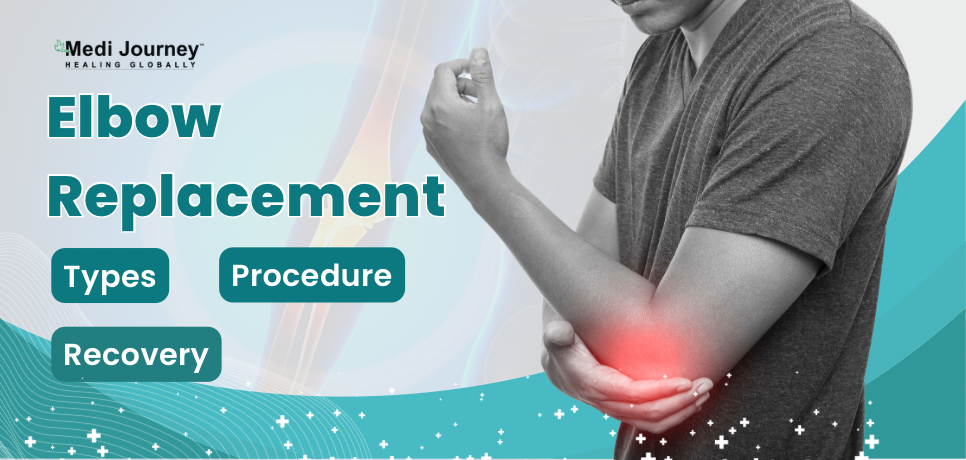PCOS and PCOD: Learn the Symptoms, Differences, and Treatment Options
 21 November,2024
Read More
21 November,2024
Read More
Enquire now in case of any assistance needed

Joint replacement surgeries have been in practice for over 100 years. In 1925, Robineau conducted the first-ever elbow replacement surgery. Though it was a complicated process in the early days, with the advancements in surgical techniques, the procedure has become more manageable and less risky.
An orthopedic surgeon can perform a total elbow replacement or TER. Selecting an experienced surgeon is essential to ensure the best possible outcome. Look for orthopedic surgeons specializing in joint replacement surgeries with extensive elbow replacement experience.
This blog post will discuss what elbow replacement is, how the procedure is performed, the expected results, recovery tips, and associated costs.
Elbow arthroplasty, also known as elbow replacement, is a surgical procedure to correct abnormalities in the elbow joint. The surgery involves replacing a damaged or deteriorated elbow joint with an artificial one, called a prosthesis.
The main goal of elbow arthroplasty is to restore mobility and improve the functioning of the elbow joint, reducing pain and enhancing the patient's quality of life. The prosthesis may be linked or unlinked. In linked elbow replacement, the hinge connects the implants, while in unlinked elbow replacement, the metal stems are linked through the body's tissue.
Elbow pain can hamper your daily life activities. Understanding the different types available is crucial if you're exploring elbow replacement surgery. Here's a breakdown of the two main options:
It is the most common type of elbow replacement. In this procedure, the entire elbow joint, including the damaged parts of the lower arm bone (ulna ) and the upper arm bone (humerus), is replaced with artificial components. These components typically consist of:
Advantages:
Disadvantages:
A partial elbow replacement procedure replaces only a part of the elbow joint, typically focusing on the damaged area. It's often used for specific conditions like:
Advantages:
Disadvantages:
Consulting an orthopedic surgeon is essential to discuss your situation and determine the most suitable option. They help explain the pros and cons of each type of replacement and address any questions you may have. The best kind of elbow replacement for you will depend on several factors, including:

Surgeons initially performed total elbow replacement to manage end-stage rheumatic arthritis. However, its uses have broadened with time. Surgeons are now using the procedure to treat conditions such as unfixable comminuted fracture, osteoarthritis, primary or metastatic tumor, hemophilic arthropathy, juvenile idiopathic arthritis, and post-traumatic arthritis.
A joint replacement surgeon recommends an elbow replacement when the bone or cartilage in the elbow joints gets damaged. The damage to the elbow joint reduces the range of motion and causes significant pain. Several diseases and disorders can lead to deteriorating elbow joints. These are:
Patients undergo consultations before surgery to evaluate their condition and receive proper instructions for successful results. The visits to the hospital include:
Once the elbow replacement surgery is complete, the hospital staff will take you to the recovery room. The surgical team will prescribe several antibiotics to prevent infection.
Feeling pain for a few days after a total elbow replacement is normal. The surgeon will advise medications like NSAIDs, opioid analgesics, and local anesthetics for pain management.
You can improve surgical outcomes and speed up your recovery process in several ways. These include –
Recent advances in prosthesis designs and surgery techniques have significantly improved total elbow arthroplasty. The surgery now achieves better and more reliable outcomes than a few decades ago. Over 80% of elbow replacements now last more than ten years. However, choosing renowned orthopedic hospitals with modern medical equipment is crucial for better results.
Recovery from total elbow arthroplasty usually takes 12-15 weeks. You can expect a complete recovery in one year. Once recovered, patients can resume day-to-day activities that were challenging before the surgery. The long-term outcomes of total elbow replacement include:
Doctors may advise avoiding activities with a risk of falling (such as horse riding), contact sports (like football), and heavy lifting (limiting weight to 5-10 pounds).
The elbow replacement procedure becomes crucial for patients who cannot be managed with medications and physical therapies. However, costs can sometimes be a constraint for such people. Western nations offer elbow replacement surgeries for USD 15,000 to USD 20,000.
Countries like India offer affordable treatment plans for elbow replacement. The cost of elbow replacement surgery in India is between USD 5,000 and 7,000. It includes preoperative diagnostic tests, the price of the implant, surgery, a hospital stay, physiotherapy, and postoperative costs.
Total elbow replacement is a complicated surgery that requires a well-equipped hospital and a skilled surgeon to achieve positive outcomes. Medications, such as DMARDs, can help control conditions like rheumatoid arthritis that may eventually lead to elbow replacement. However, elbow replacement surgery is often the only option if the disease has progressed. The procedure can significantly improve the patient's range of motion, joint function, and overall quality of life.
Doctor of Pharmacy
Dr. Deepanshu Siwach is a skilled clinical pharmacist with a Doctor of Pharmacy degree. He has 4+ years of experience and has worked with thousands of patients. He has been associated with some of the top hospitals, such as Artemis Gurgaon and Teerthanker
Director
Orthopedic and Joint Replacement Surgeon
Aakash Healthcare Super Speciality Hospital, Dwarka, New Delhi
Dr. Aashish Chaudhry is amongst the best Orthopedic Surgeons, with over 23 years of experience....
Senior Consultant
Medical Oncologist
Nanavati-Max Super Speciality Hospital, Mumbai
Book an Appointment Talk To ExpertSenior Director
Gynecologist and Obstetrician, IVF Specialist
Max Super Speciality Hospital, Shalimar Bagh, New Delhi
Book an Appointment Talk To ExpertSenior Director
Gynecologist and Obstetrician, IVF Specialist
Max Smart Super Speciality Hospital, Saket, New Delhi
Book an Appointment Talk To ExpertSenior Director
Gynecologist and Obstetrician
Max Smart Super Speciality Hospital, Saket, New Delhi
Book an Appointment Talk To ExpertSenior Director
Gynecologist and Obstetrician
Max Smart Super Speciality Hospital, Saket, New Delhi
Book an Appointment Talk To ExpertSenior Director
Gynecologist and Obstetrician
Max Smart Super Speciality Hospital, Saket, New Delhi
Book an Appointment Talk To ExpertFill up the form and get assured assitance within 24 hrs!
The Art of Effective Communication
 05 November,2024
Read More
05 November,2024
Read More
 29 October,2024
Read More
29 October,2024
Read More
 28 October,2024
Read More
28 October,2024
Read More
Trusted by Patients
"I am Asim from Bangladesh and was looking for treatment in India for neuro. I visited many websites to get the complete information regarding the treatment but I was not satisfied as I was getting confused. In the meanwhile, one of my friends suggested I seek help from Medi Journey as he experienced his medical journey very smoothly and was satisfied with it. They have filtered the top 10 doctors as per experience, the success rate of surgery & profile, so it helps us to choose the best treatment in India. "
"For my knee surgery, Medi Journey guided me to BLK Hospital where I received exceptional care. The team's support and the expertise at BLK Hospital exceeded my expectations. Thank you Medi Journey for making my medical journey stress-free. "
"I came from Iraq for my granddaughter's eye surgery in India facilitated by Medi Journey, due to critical cases they advised us to get a second opinion from the different hospitals before going to surgery. Finally, we went to Fortis Escort Hospital, which helped us to get more confidence for diagnosis. Fortis Escort Hospital has the best eye surgeon team with the latest instruments. Thanks to all team members for providing a high-quality treatment in India at an affordable cost. "
"I came for my hair transplant in India, before coming I was so confused about choosing the best clinic and surgeon for me. But thanks to God one of my friends had a hair transplant in India through Medi Journey. He recommended me to go with them. I am completely happy with my experience with them. They were always very fast in their responses to me. the success rate of my hair transplant surgery is 100%."
"Artemis Hospital, suggested by Medi Journey, turned out to be a great choice for my treatment. The personalized assistance and medical care were exceptional. I'm grateful to Medi Journey for guiding me to a hospital that perfectly matched my needs. Highly recommended! "
"I came from Afghanistan for my treatment in India at Jaypee Hospital, Noida. I had a fantastic experience with Medi Journey. Kudos to them for their incredible support during my medical journey. They not only took care of all the logistics but also connected me with a fantastic healthcare team. Efficient, caring, and highly recommended for a hassle-free medical tourism experience."
"I am Adam from Kano, Nigeria, one of my friends from Nigeria was facilitated by Medi Journey, and he recommended us to go with them. I sent my all reports to them and within 48 hours they reverted with 4 options from different hospitals. They helped me to get a Visa letter from the hospital, arrange pick-up from the airport, and book a hotel for me. Their team is very honest and throughout our stay in India they are with us they are caring for us like his family members. BLK Hospital is the best hospital in India with a top surgical oncologist surgeon team, a very advanced OT, and a Radiotherapy department. I wish more success to Medi Journey. "
"Great experience at the Max Hospital for my spine surgery and was successfully done. I thank my neurosurgeon and his entire team. I recommended all of my country's people to Medi Journey for treatment in India, they choose the best hospital, the best doctors, and the best cost for patients."
"I came to India from Dhaka, Bangladesh for my father-in-law's cardiac surgery at Fortis Hospital. I was confused about choosing the best surgeon for him before coming, but their team helped me to choose the best hospital and best cardiac surgeon in India with very good cost and 100% success rate of surgery. I am very happy with the services, really they make my journey so comfortable that make me feel at home. Thanks again and I like people to choose "Medi Journey" as your travel guide. "
"I am Mohammad from Bangladesh came to India for my general health checkup. Medi Journey offers me the complete package including Pick-up from the airport, hotel services, and 24-hour assistance. They guide you to choose the best hospital in India, the best cost of treatment with top-most doctors and give you complete information about hotel booking, and pick-up from the airport before coming to India They have the best team to help. Always choose Medi Journey for your treatment in India."





